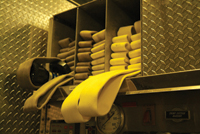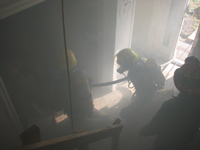
Features
Structural
Training
Back to Basics: October 2010
In the July issue of Back to Basics, we discussed the acronym AWARE – air, water, a radio and extrication – and looked at the importance of air in the rescue of a downed firefighter.
October 18, 2010
By Mark van der Feyst
In the July issue of Back to Basics, we discussed the acronym AWARE – air, water, a radio and extrication – and looked at the importance of air in the rescue of a downed firefighter. Now, we’ll look at water and a radio and their importance to the rapid intervention team (RIT). We’ll discuss extrication next time.
In order for RIT members to rescue a mayday firefighter, there must be a defendable space around the downed firefighter. This can be accomplished by bringing in a charged hose line to protect the mayday firefighter and the RIT members from fire and heat. This is especially important in situations in which the mayday firefighter has fallen through the floor into the basement or become lost or trapped.
 |
|
| The hose line needs to be staged at the staging area, charged and ready to go, rather than on the apparatus waiting for deployment. Photo by Mike Gutschon |
Even though there may be established hose lines going into the structure for various reasons, the RIT needs to have a dedicated hose line ready for deployment. A charged hose line should be present at the staging area where the RIT equipment is set up. This charged hose line is a just-in-case piece of equipment that will be vital to the success of the rescue. The hose line should be charged and ready to go, rather than staged and dry on the apparatus hose bed. Time is crucial in the rescue of a mayday firefighter; deploying a hose line from the apparatus, flaking it out, charging it, then bleeding off the air and advancing it into the structure eats up precious minutes.
Advancing a hose line into a structure is not a job one firefighter can do alone; it requires two to three firefighters. If your RIT is staffed by only two firefighters, additional resources will be needed in the form of mutual aid or additional alarms, which will bring in more fire companies. Depleting the on-site resources that are focusing on the structure fire is not wise; they are needed to prevent the incident from getting worse.
Using a hose line to produce a defendable space is a job the mayday firefighter can do if he is conscious and able to help; having him control the hose line allows him to focus on the task at hand and not on himself. This makes him feel like he is part of the rescue and it frees up manpower. If the mayday firefighter in not able to assist, a dedicated firefighter is needed to create that defendable space.
Depending upon the area in which the mayday firefighter is trapped, rescuers may be able to use specialty nozzles to create the defendable space. Most apparatuses carry special nozzles that are rarely used at structure fires, such as cellar nozzles, piercing nozzles, water curtain and water distributors. These special nozzles can be used to provide water protection around the mayday firefighter and RIT members.
 |
|
| The rapid intervention team advances a hose line into the structure to protect the RIT operation. Photo by Mark van der Feyst |
Another way to create a defendable space is to use positive pressure ventilation. Under mayday procedures, initiating Tactical Mayday Ventilation (TMV) is an option that can be exercised. The introduction of TMV will result in the quick removal of smoke and heat. TMV must be done in accordance with the fire conditions; TMV can be deadly if it is not done properly. There needs to be one opening and one exit point of sufficient size. Situations that would prohibit using TMV are backdraft conditions, high wind conditions from the leeward side, a volatile environment or if the mayday firefighter is close to or blocking the potential exhaust point.
Hopefully, the mayday firefighter has a radio and can communicate with command and pass on valuable information. If he does not have a radio, or if the radio has failed, the RIT needs to get a radio to him. The radio is a vital link between the downed firefighter and command; it allows command to ask questions about the environment that the mayday firefighter is in, his condition and air supply, the whereabouts of his partner or crew members and tactical questions about how to rescue him. Using the mayday firefighter to gather information and communicate with command keeps the mayday firefighter focused on the task at hand, and not on his predicament. It also keeps him involved in the incident so he doesn’t feel left out.
The radio can also be used to distract the mayday firefighter if he is too focused on his situation. Having a dedicated person to speak to the mayday firefighter allows the RIT to work without any interference from the mayday firefighter; this is similar to the procedure used at motor vehicle collisions in which one rescuer focuses on the victim for the duration of the operation.
Mark van der Feyst is an 11-year veteran of the fire service and works for the City of Woodstock Fire Department in Ontario. He teaches in Canada, the U.S. and India. Mark is a local level suppression instructor for the Pennsylvania State Fire Academy, an instructor for the Justice Institute of B.C. and a professor of fire science for Lambton College. He can be reached at Mark@FireStarTraining.com
Print this page